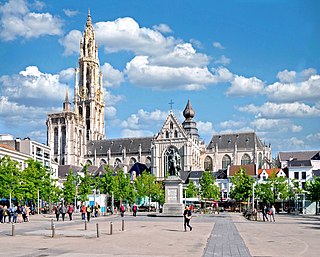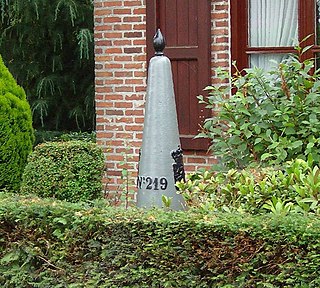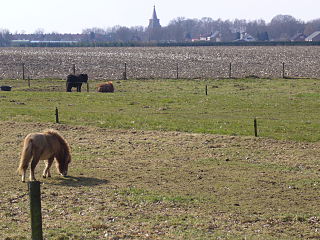
Edegem is a municipality located in the Belgian province of Antwerp. The municipality only comprises the town of Edegem proper. On January 1, 2006 Edegem had a total population of 21,668. The total area is 8.65 km² which gives a population density of 2,504 inhabitants per km². The old Sint-Antoniuskerk is no longer open to the public. It is not sure when it was first built.

Malle is a municipality located in the Campine region of the Belgian province of Antwerp. The municipality comprises the villages of Oostmalle and Westmalle. On 1 January 2013 Malle had a total population of 14,950. The total area is 51.99 km2 which gives a population density of 288 inhabitants per km2.

Sint-Pieters-Leeuw is a Dutch-speaking municipality of Belgium located in the province of Flemish Brabant.

The Cathedral of St. Michael and St. Gudula is a medieval Roman Catholic cathedral in central Brussels, Belgium. It is dedicated to Saint Michael and Saint Gudula, the patron saints of the City of Brussels, and is considered to be one of the finest examples of Brabantine Gothic architecture.

Westmalle is a village in the Belgian province of Antwerp which is part of the municipality of Malle.

Opdorp is one of the three towns making up the municipality of Buggenhout in East Flanders, Belgium. Sometimes it's classified in the Denderstreek.

Heist-Goor is a village of Heist-op-den-Berg, that is situated in the south of the province of Antwerp. In the old days there was a swamp on this location.

The Cathedral of Our Lady is a Roman Catholic cathedral in Antwerp, Belgium. Today's see of the Diocese of Antwerp started in 1352 and, although the first stage of construction was ended in 1521, has never been 'completed'. In Gothic style, its architects were Jan and Pieter Appelmans. It contains a number of significant works by the Baroque painter Peter Paul Rubens, as well as paintings by artists such as Otto van Veen, Jacob de Backer and Marten de Vos.

The Campine or De Kempen is a natural region situated chiefly in north-eastern Belgium and parts of the south-eastern Netherlands which once consisted mainly of extensive moors, tracts of sandy heath, and wetlands. It encompasses a large northern and eastern portion of Antwerp Province and adjacent parts of Limburg in Belgium, as well as portions of the Dutch province of North Brabant and Dutch Limburg around Weert.

Merksem is a district of the municipality and city of Antwerp in the Flemish Region of Belgium. It has 44,808 inhabitants as of 2021.

Oostmalle is a village which is located in the Belgian province of Antwerp. The village itself is part of the municipality of Malle.

The Castle de Renesse is a castle located in the village of Oostmalle (Malle), in the Campine region of the province of Antwerp. It is currently owned by the municipality of Malle.

The hamlet of Blommerschot is located in the southeast of Oostmalle in the Campine region of Flanders, Belgium. Blommerschot was already mentioned in 1300 as Eene oude Ridderlyck hof, and possibly dates back from a Frankish settlement. In the 17th century it was owned by Johan de Proost, Lord of Wechel, who obtained the feudal rights of the Land of Turnhout from Philip IV Duke of Brabant in 1626.

Ommegang or Ommeganck is the generic name for various medieval pageants celebrated in the Low Countries.

Melsele is a town in the Belgian province of East Flanders, between the city of Beveren and the nearby town of Zwijndrecht. Tram route 3 which starts just outside the town connects it to Zwijndrecht and Antwerp. The town's road links include the E17 and the E34.

Nieuwkerken-Waas is a village in the Belgian province East Flanders. Since 1977, it has been a subdivision (deelgemeente) of the municipality of Sint-Niklaas.

The Church of Our Blessed Lady of the Sablon is a Roman Catholic church located in the Sablon/Zavel district in the historic centre of Brussels, Belgium. It is dedicated to Our Lady of the Sablon.

The St. Paul's Church or Sint-Pauluskerk is a Roman Catholic church located at the Veemarkt in Antwerp. Its exterior is mainly Gothic with a Baroque tower while the interior is characterised by its rich Baroque decoration. It holds paintings by Antwerp's leading artists Peter Paul Rubens, Anthony van Dyck and Jacob Jordaens as well as abundant sculpture and church furniture crafted by leading Antwerp sculptors such as Artus Quellinus the Elder, Pieter Verbrugghen I, Jan Pieter van Baurscheit de Elder, Jan Claudius de Cock and Andries Colyns de Nole. Of particular note is the Calvary outside the Church which is made up of 63 life-size statues and nine reliefs executed in a popular and theatrical style.

Meersel-Dreef is a village in the Belgian municipality of Hoogstraten in the province of Antwerp, Belgium.

Tienray is a village in the Dutch province of Limburg. It is a part of the municipality of Horst aan de Maas, and is located about 15 kilometres (9.3 mi) north of Venlo.





















